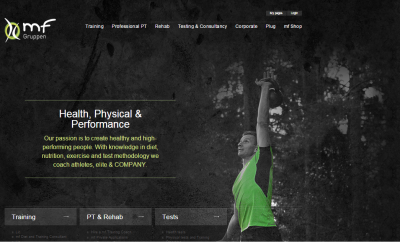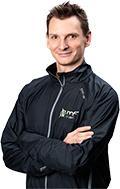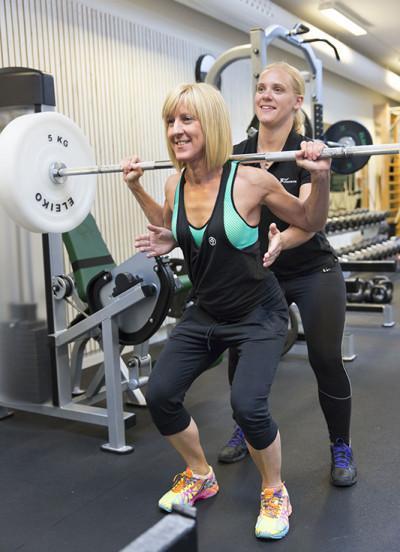
Exercise is not effective for weight loss but it's great for many other things - health, strength, well-being etc. Did you want to start exercising once and for all in January this year? Have you been able to keep it up?
Keeping up your drive and enthusiasm for exercise can be tough - and there's nothing easier than relapsing to old habits. But arm yourself with the right strategy and motivation, and anything is possible. Today our expert on exercise gives his best advice.
Jonas Bergqvist is a licensed physical therapist who's worked with dietary, exercise and lifestyle coaching for many years. He currently runs a combined health and education centre with courses in, among other things, LCHF and paleo dietary advice. He's also a popular diet guru and has written several diet and exercise books, including (in Swedish) "LCHF and Exercise".
Now it's time for his best advice for those of you who want to learn how to exercise in a way that will be sustainable in the long term.
(1) Häkkinen K, Komi PV. Electromyographic changes during strength training and detraining. Med Sci Sports Exerc. 1983;15(6):455-60
How to beat the two-month slump in exercise motivation
This is the third and final post in my series about establishing sustainable exercise habits. Early this year, the first part was published here on DietDoctor about the best way to get started with exercise. The second part, published in March, highlighted exercise especially for people with metabolic disorders and overweight, and this third part is about how to deal with how to keep new exercise habits alive. How do you get past the plunge in motivation that normally occurs after two-three months?
The previous posts were chock-full of facts and referenced several scientific studies. This post is different. This is simply because your drive to exercise is a highly mental thing, and in order to keep exercising after doggedly pushing on for a few months only on willpower, you need the right mental approach and attitude.
During the spring I've received feedback on my other posts: for one thing, I've heard that the inspiration was right on, but I've also been told that the exercises I suggested were too difficult, that they didn't work for people with chronic knee pains, back problems or obesity etc. The truth is: the more specific a message becomes, the higher the risk of excluding a larger audience. I would like to repeat that the principles outlined here are general, and that individually adapted exercise routines can only be put together after thorough screening, analysis and instruction in person.
Now, many months in, my guess would be that only a select few of the readers who let themselves be inspired to exercise at the beginning of the year still keep at those routines today. The statistics are in fact pretty bleak when it comes to establishing new routines or habits in a process of change.
The difficulty in making long-term changes last
People have a tendency to let themselves fall back into old habits after two-three months of conscious effort. This phenomenon is also typically seen in weight loss studies, where participants often stop adhering to the program two-three months in. And it's just as noticeable in the exercise field for anyone who starts exercising. Experiencing the first few "honeymoon" months, when you feel a significant (and often steady) positive development in energy, strength, fitness, physique and body composition - this will encourage you to keep pushing on only in the beginning.
I notice this a lot in new customers I meet. For those who haven't been very active before, and who just want some tricks to get going with exercise on their own, the outlook is grim. And it's not a lack of knowledge that stops these people from succeeding. They may get the best tips, the best exercise plans, but in the end it's a question of a behavioral change, a lifestyle change, and that's more difficult than many people realize. If we look at this from a broader perspective, we might ask: why do people eat things that are bad for them, or exercise too little, or stress too much, or sleep too little, when we know all of that is unhealthy? It doesn't matter that people are aware of these things - they may still ultimately not follow that advice. It's obviously not an issue of a lack of knowledge.
What perks up the adherence stats (i.e. makes more people stick to a program) is if they are guided by a professional who continuously motivates, changes and coaches them to results. A professional who can draw them out of their comfort zone when necessary.
Mindset and drive
Of course you can change your lifestyle on your own. There are many examples of people who've managed. Many times, the key lies in asking some deeper questions related to one's own behavior: for whom am I exercising? For what am I exercising? To overcome the inner voice that keeps you from exercising, and to be able to sustain lasting changes in habits, you have to understand your deeper drives.
If your goal is to optimize your health without exercise, that's absolutely fine - as long as you take responsibility for the health you are foregoing in making such a decision. If you want to exercise for fun, take responsibility for the fact that the effect you are getting is derived from the passion for fun and joy within you, and not from physical or mental needs. An optimal exercise routine is often based on a mix of bits you think are fun because you're good at them, and some bits that you don't find as fun, but nevertheless need. It's not like many people get a kick out of rehab exercises for example!
If you decide to use exercise to gain optimal health benefits, you have to realise that not every training session is going to be fun. Every training session doesn't need to be fun. Work on your attitude and come to terms with the fact that you sometimes have to accept to just perform a training session, knowing that it will take you towards a greater goal. Some days, you won't feel like working out. In that situation, a person who's driven by pleasure will do something completely different than put on his or her running shoes and go work out - but in order to optimise your health, you should perform this workout too. These are the days that make a difference. I mentioned this already in the first part, and recommended setting a performance goal 2-6 months ahead. Experience has taught me that this increases the tendency to go through with workouts even on bad days. A performance goal will give you direction, as well as proof of your progress.
Continue to improve the environment around you
Lifestyle changes are tough. Establishing exercise habits after one, two or more years of sedentary life isn't easy, and you have to continuously reflect on what you're doing. Besides your mindset and attitude, you need to make sure that external factors won't hold you back or create problems for you after a few months of regular exercise. Will you still have functioning equipment then? Are your training clothes still alright, or would a new set of clothes increase your motivation levels? Make sure you still pack your workout bag the night before, that you still take out your running shoes and put them where you can see them in the morning. Prepare in every way you can for tomorrow's workout. Keep remembering to schedule your workouts. Personally, I've scheduled my workouts in my work calendar. I tell the people I'm around that I'm in a meeting if someone wants to get my attention during my own training sessions. It's still not entirely socially acceptable to turn down people in favor of one's own workouts, but do try to develop a higher understanding at your workplace.
Understand what your body needs
There are several physiological phenomena that appear after two months of regular exercise which are worth thinking about if you want to boost your willpower and the motivation to stick to your exercise plan. In many people, the results from exercise tend to reach a plateau after a couple of months, which can be explained physiologically.
During the first 6-8 weeks of regular exercise, increased strength is largely attributable to improved communication between muscles and nerves (1). Your body simply becomes stronger because it gets better at using what it already has. Only a minor part of the improvement stems from any actual increase in muscle mass, and this increase will primarily be more water retention anyway. You won't get all much more muscle protein from 6-8 weeks of regular exercise on an amateur level.
After 6-8 weeks, a larger part of your increase in strength will be derived from an actual increase in muscle mass - but achieving this demands a more powerful anabolic signal during your workouts compared to what you needed during the first weeks (the "honeymoon" period).
What do you need to do? Well, varying your workouts is always a plus, and you'll also need to keep increasing the load to keep developing your body. This becomes more crucial after the first 6-8 weeks.
The value of a personal trainer (P.T.)
Throw yourself out of your comfort zone! Book an appointment with a personal trainer at this stage, in order to get an update on your exercise routine as well as an extra motivational kick! It's also sensible to accept that the development curve you've been seeing for the past 6-8 weeks of regular exercise is tough to keep up. After all, the more fit you get, the more it takes to get even fitter.
Another important aspect to consider is: the more strain you put on your body as you push for better fitness and physique, the more your risk of injury will increase. This is why I encourage you to start thinking in terms of a corrective strength routine and a corrective exercise program.
Let me illustrate this with an example: I used to coach a professional golf player for whom I devised a so-called corrective technical exercise plan. It included stretching and stability exercises and had the purpose of keeping her injury-free while performing strength workouts.
The corrective technical exercise plan included flexibility exercises for the joints she needed more flexibility in, and stability exercises for areas where she needed improved muscular balance. The program was meant to allow the golfer to safely perform her more advanced training routine. In this case, she was doing some pretty advanced and heavy weightlifting - which in its turn was meant to keep her injury-free while practising golf for 6 hours a day.
Be inspired by this philosophy - use an exercise plan that gives you the flexibility and stability you need to perform the strength and cardio exercises you do, in order to keep injury-free in your everyday life, and to feel good. As a beginner, you can have the same tactic as a professional golf player - even if the content, level of ambition and discipline differ.
It's not easy to design your own corrective technical routine, so solicit the help of any well-regarded PT. Some of the exercises can probably be integrated into your normal workouts, but if you have aches and pains or long-term injuries, you'll most likely need to let yourself focus on your technical routine. Unfortunately, it's not uncommon for amateurs to injure themselves exercising, and it's often a result of over-exertion, muscular imbalances, bad flexibility and poor technique. A corrective technical routine will allow you to stay healthy and fit.
In conclusion
If you really want to achieve long-term change, you're going to have to deal with deep personal things such as your sense of identity and your set of values. This is where you'll find the key to long-term, sustainable change. If you're instinctively thinking of excuses as to why the tips I've given in this series of posts don't apply to you, or how they can't possibly help you, then maybe it's time to say goodbye to all those excuses and instead focus your energy in another direction. Start to see possibilities instead of problems.
These final lines feel like an invitation to a new series of articles on personal development. Although that's not my area of expertise, and nothing I am qualified to write about, it's so important that I'll still choose to end on this note.
I hope you've found an extra motivational nugget when it comes to exercise, some instructive advice or perhaps an interesting new thought. If just one of you have gotten something valuable from my guest posts, then they've been worth writing.
Good luck!
Jonas Bergqvist
[email protected]
Thanks for the third and final part, Jonas!
The MF Group where Jonas works has many things to offer: educational courses, rehab, personal trainer services, health and exercise-related books and fitness tests. However, their website is currently available only in Swedish. If you're interested in just taking a look, here's their site translated by Google:




